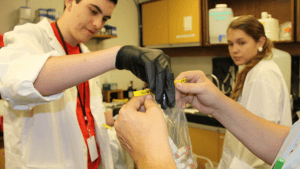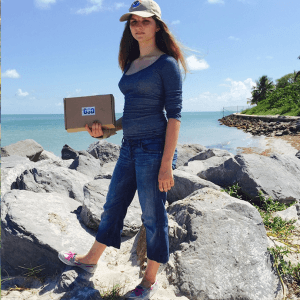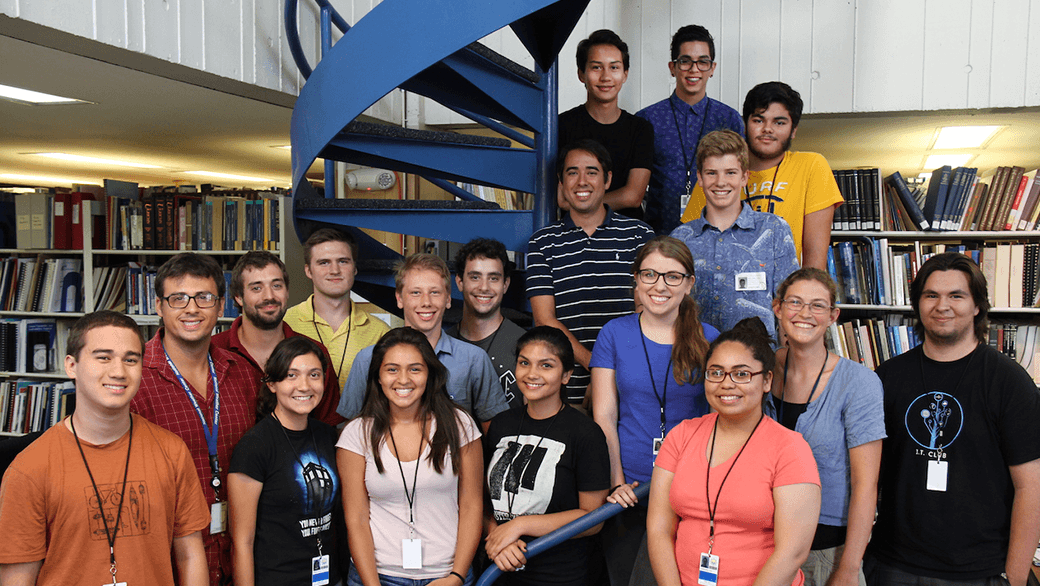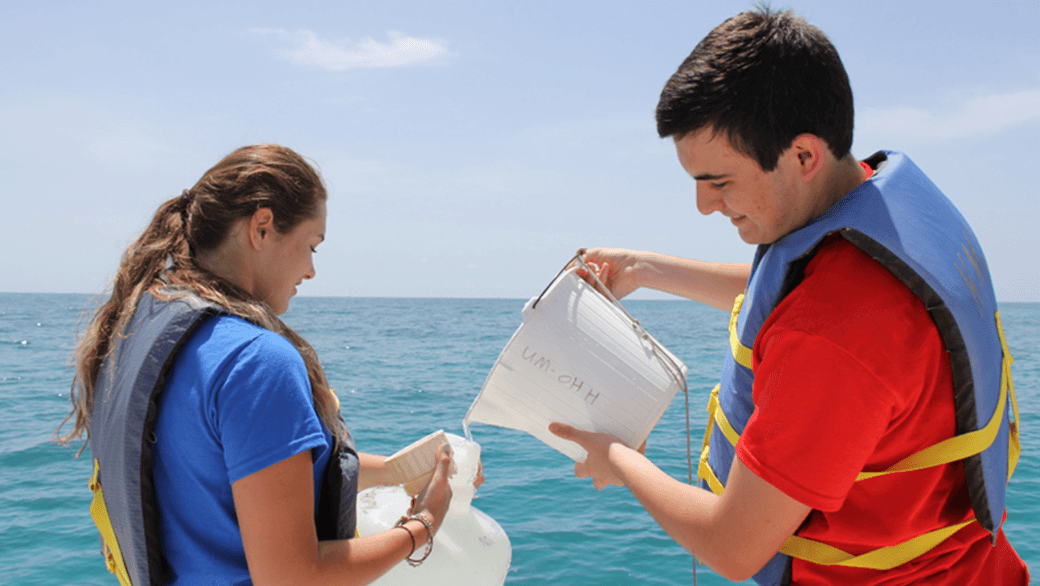The 2016 Atlantic Oceanographic and Meteorological Laboratories’ (AOML) cadre of summer interns inspired us with a very promising group of motivated individuals. Fourteen students came from all over the country to complete a wide array of projects in different thematic areas of AOML’s workforce; Physical Oceanography, Ocean Chemistry and Ecosystems, Hurricane Research, Engineering, and Communications.AOML is home to some of the nation’s leading scientists, and internships offer a great opportunity for students to learn alongside these experts and develop skills that they will take with them in the future. The summer internships also expose students to careers at a federal research laboratory. NOAA offices are located all across the country, so students who enjoy their summer internship can consider NOAA or other federal science agencies for future employment when they enter the workforce.
AOML Welcomes Aboard Summer 2015 Interns
AOML welcomes 22 young men and women, including new and returning high school, undergraduate, and graduate students, who are completing internships at the lab this summer. Over the course of their six to ten week internships, students will work with mentors in the fields of Ocean Chemistry & Ecosystems, Physical Oceanography, and Hurricane Research, as well as specialists in Computer Networks and Services, Administration, and Communications, to participate in field sampling efforts, perform data analysis, and create new content for internal and external websites.
AOML’s internship opportunities provide students with experiences that motivate and prepare them for careers aligned with NOAA and its industry and university partners. For many students, these internships are unique experiences that provide an opportunity to learn from some of the nation’s leading scientists. They participate in activities that support ongoing AOML research, and sometimes create new opportunities that become the foundation for their first scientific publication.
Each intern works alongside their AOML mentor to conduct research activities that match their educational interests and background. Their assigned work includes experimental data collection and processing, equipment design and testing, field research, and computer software and web content development. Some of the specific internship projects this summer include:
- water quality field sampling efforts and use of molecular techniques to assess and characterize microbial contaminants;
- examining particular storm characteristics that influence hurricane development in an effort to improve hurricane intensity forecasts; and
- observing and modeling climate fluctuations in the central and northeastern Tropical Atlantic.
Many of these projects are at the cutting edge of science and technology, and all are important to future NOAA research efforts.
The group of talented students hails from local Miami-Dade high schools and higher learning institutions such as MAST Academy, G. Holmes Braddock Senior High School, Miami-Dade College, and the University of Miami, as well as other U.S. and International universities. The group also contains three undergraduates from the prestigious Hollings Scholarship Program. Administered by NOAA, the program provides support and multidisciplinary learning experiences for undergraduate students interested in pursuing research, public service, or teaching careers in the oceanic and atmospheric sciences.
AOML Enlists Citizen Scientists for International Ocean Sampling Day 2015
Researchers with AOML’s Environmental Microbiology Lab joined a global effort to sample the smallest members of the ocean ecosystem on June 21 during International Ocean Sampling Day. Organized and led by the European Union’s MicroB3 organization and the Ocean Sampling Day Consortium, Ocean Sampling Day (OSD) is a simultaneous sampling campaign of the world’s oceans and coastal waters. These cumulative samples, related in time, space and environmental parameters, contribute to determine a baseline of global marine biodiversity and functions on the molecular level.
What are scientists looking for?
The organisms of scientific interest for the OSD campaign include microscopic Bacteria, Archaea, Fungi, Protists and viruses, collectively known as microbes. Microbes make up 98 percent of the biomass in Earth’s oceans and are responsible for most of the biological activity that takes place within it. Microbes are found everywhere, from the ocean surface to deep within rocks beneath the ocean floor. They are pervasive and can evolve rapidly in response to changes in the environment. In fact, many scientists consider microbes to be a “canary in the coal mine”, signaling local and global changes in the oceans. It is, therefore, important to acquire information from across the globe on this vast community of organisms, against which future changes can be observed and measured.
2014: The first global OSD effort
During the 2014 Ocean Sampling Day event, over 180 scientific teams participated from all continents ranging from subtropical waters in the Caribbean to extreme environments in the Antarctic Ocean. On this day, more than 600 people all around the world took water samples from the ocean in order to identify the microbes within. Scientists used the data collected to support projects focusing on environmental microbiology parameters that describe the relationship between marine microbes and human health and the health of our local marine ecosystems. This data will also provide insights to the ocean economy through the identification of novel, ocean-derived biotechnologies.

Researchers with AOML’s Environmental Microbiology Lab joined a global effort to sample the smallest members of the ocean ecosystem on June 21 during International Ocean Sampling Day. Organized and led by the European Union’s MicroB3 organization and the Ocean Sampling Day Consortium, Ocean Sampling Day (OSD) is a simultaneous sampling campaign of the world’s oceans and coastal waters. These cumulative samples, related in time, space and environmental parameters, contribute to determine a baseline of global marine biodiversity and functions on the molecular level.
What are scientists looking for?
The organisms of scientific interest for the OSD campaign include microscopic Bacteria, Archaea, Fungi, Protists and viruses, collectively known as microbes. Microbes make up 98 percent of the biomass in Earth’s oceans and are responsible for most of the biological activity that takes place within it. Microbes are found everywhere, from the ocean surface to deep within rocks beneath the ocean floor. They are pervasive and can evolve rapidly in response to changes in the environment. In fact, many scientists consider microbes to be a “canary in the coal mine”, signaling local and global changes in the oceans. It is, therefore, important to acquire information from across the globe on this vast community of organisms, against which future changes can be observed and measured.
2014: The first global OSD effort
During the 2014 Ocean Sampling Day event, over 180 scientific teams participated from all continents ranging from subtropical waters in the Caribbean to extreme environments in the Antarctic Ocean. On this day, more than 600 people all around the world took water samples from the ocean in order to identify the microbes within. Scientists used the data collected to support projects focusing on environmental microbiology parameters that describe the relationship between marine microbes and human health and the health of our local marine ecosystems. This data will also provide insights to the ocean economy through the identification of novel, ocean-derived biotechnologies.
Where are AOML scientists sampling?
This year, AOML will coordinate and sample ten OSD sites across the country. In addition to the 2014 sites in the Florida Keys, Ft. Lauderdale, Tampa Bay, La Jolla, California, and Horn Island, Mississippi, AOML will coordinate five new sites spread across the Florida peninsula from Pensacola to Miami. Sampling sites are expected to be monitored long-term as part of the international Genomic Observatories Network and the resulting database will be accessible to the public.
MyOSD: The citizen scientist component
OSD organizers have amended the citizen science component for this year’s event, allowing individuals from all over the globe to collect samples in their backyard using handy sampling kits. This component, called MyOSD, gives individuals the chance to help scientists unravel the mysteries of the marine microbial world by collecting important environmental data such as latitude, longitude, temperature, salinity, pH and wind speed.

A citizen scientist from MAST Academy samples a site on Key Biscayne with a MyOSD kit. Image Credit: NOAA
AOML has coordinated and provided kits to a number of citizen science groups in Florida and California, including organized youth groups, citizen science organizations, educational centers, and outreach groups. Samples collected will represent a variety of different marine ecosystems including the open ocean, beaches, coral reefs, and estuaries.
We are excited to be working with a number of citizen scientists this year to expand our sampling effort and help contribute to our understanding of the ocean’s biodiversity said AOML. “
-Microbiologist Dr. Chris Sinigalliano
A baseline for the future
With the combined effort of researchers and citizen scientists, OSD 2015 continued the initiative to collect and share crucial information that can be used as a reference for generations of experiments to follow in the coming decades. Additionally, the data analysis procedures being developed for OSD are driving the field forward, but it is clear that much remains to be discovered about the microbial world. Scientists hope that such large-scale projects that provide an “ecological snapshot” become increasingly more common as they are essential for understanding the complexity of Earth’s systems.
Originally Published by Edward Pritchard, 2015

